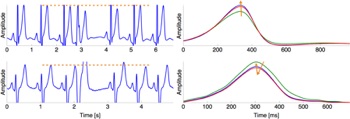Quantifying PEST in Holter ECGs and evaluating its usage to stratify risk of cardiac death in patients with chronic heart failure
- chair:Digital signal processing
- type:Student research project
- tutor:
Dipl.-Ing. Gustavo Lenis, M.Eng Julia Ramirez
- person in charge:
-
MotivationThe risk stratification of cardiac death in patients with chronic heart failure and, in particular after myocardial infarction (MI), plays an important role in cardiology. It influences the treatment of a patient and the use of implantable devices. However, the majority of well known methods for stratifying risk still fail to predict sudden cardiac death with high accuracy. The heart rate turbulence delivers good results that could be complemented by studying ECG morphology. For this purpose, the post extrasystolic T wave change (PEST) in the electrocardiogram (ECG) should be studied.
In order to answer the question if PEST can be used to improve risk stratification in patients with chronic heart failure, the large dataset MUSIC should be considered. Applying state of the art signal processing algorithms, PEST parameters should be computed and a statistical assessment should be carried out. In the end, it could be stated if the new PEST parameters can predict heart related death. A collaboration with the group BSICoS at the University of Zaragoza will bring new knowledge and expertise to the research project.
Tasks
In this project, a robust algorithm for the quantification of PEST in Holter ECGs should be developed. Subsequently, the PEST parameters should be computed. Using statistical analysis, the relevance of the newly obtained parameters for risk stratification should be assessed.Requirements
- Literature research
- Programming skills in MATLAB
- Strong fundamentals of signal processing
- Statistics and data mining
- Ideally, fundamentals of cardiac physiology and anatomy

